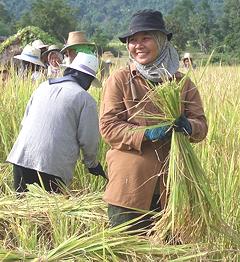
[Oryza sativa var indica]
The earliest hard evidence of rice cultivation we have is from China, but rice was native to either Southeast Asia or southern India, so was probably cultivated there much earlier. Wet tropical regions are not noted for preserving evidence. Photo by ryanwh distributed under license Creative Commons Attribution-ShareAlike v2.0 Generic.
Rice remains critically important throughout Southeast Asia, because the region is too hot and wet for other grains. The predominant type for meals is long grain Jasmine rice, except in Laos and Issan, the Lao region of Thailand. There, Thai Long Grain Sweet Rice dominates. The rest of the region uses sweet rice mainly for sweets (thus the name), treats, and deserts.
General Information on Rice, and
Other Regions.
 [Thai Basmati; Hom Mali (Thai); Milagrosa (Philippines); Cambodia Fragrant;
Oryza sativa var indica]
[Thai Basmati; Hom Mali (Thai); Milagrosa (Philippines); Cambodia Fragrant;
Oryza sativa var indica]
This long grain and distinctly aromatic rice is preferred in much of Southeast Asia, including the Philippines. The major exporter has usually been Thailand, but due to a Thai government program they were passed by Vietnam in 2012. Some is also exported by Cambodia. It is a preferred variety grown in the Philippines, but not much exported from there. Some say it originated in the Philippines, others that it originated in Thailand. It is 15% to 18% amylose.
Sometimes called "Thai basmati", this rice remains fluffy with separate
grains (though not quite as fluffy as basmati) and is an ideal rice for
serving plain steamed with Southeast Asian, South Indian, and Southern
Chinese dishes. For northern China, typically California rice, and for
northern India, Basmati. 1 cup rice needs about 1-3/4 cups (variable
depending on age) of water to makes about 3 cups cooked rice in 25 minutes.
The photo specimens were typically 0.300 inches long and 0.075 inches wide
(7.6 x 1.9 mm).
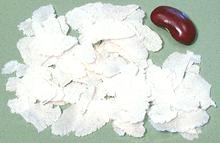 [Beaten Rice, Rice Flakes, Pounded Rice; Poha (India); Chira (Assam)]
[Beaten Rice, Rice Flakes, Pounded Rice; Poha (India); Chira (Assam)]
This product is made in the Philippines from a short grain rice. It is
used for deserts and drinks. The grains are cooked, flattened into flakes
and dried.
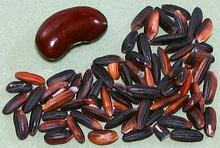 [Gao Nep Than (Viet); Purple Thai Rice]
[Gao Nep Than (Viet); Purple Thai Rice]
This is a fairly large moderately long grain sweet rice which turns to a very dark purple when cooked, and colors other ingredients it is cooked with. With the bran layer on it only becomes a little bit sticky, but it is more tender than a lot of brown rice, with a quite pleasant nutty flavor and just a little crunch at the bran layer. It is sold as a "brown rice" to preserve the unique color and flavor (the grains are white inside). A cup of this rice needs about 2-1/4 cups of water and 45 minutes cooking time. The photo specimens were typically 0.275 inch long and 0.105 inch wide (7.0 x . 2.7 mm)
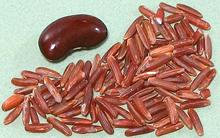 [Gao luc do (Viet)]
[Gao luc do (Viet)]
This is a long grain rice with a reddish brown bran and a "nut-like"
flavor. This is sold as a "brown" rice with the bran on to preserve
the color and flavor. "Cargo rice" means "Brown rice" in some regions.
A cup of this rice needs about 2-1/2 cups of water. Bring it to a boil
uncovered, then cover tightly and simmer for about 60 minutes. It is
still fairly chewy, but flavor is decent. The photo specimens were
typically 0.257 inch long and 0.075 inch wide (6.5 x 1.9 mm).
 [Glutinous Rice, Sticky Rice]
[Glutinous Rice, Sticky Rice]
This intensely white short grain rice is the standard type for sweet rice
through East Asia, including Japan. is not much used in Southeast Asia
where the Thai long grain dominates. This form may be used in the
Philippines, I haven't determined that for sure. Sweet rice is no sweeter
than any other kind, but gets the name from being used mainly to make
sweets and deserts. It is very high in amylopectin starch and very low in
amylose starch, so it absorbs a lot of water and is very sticky. The photo
specimens, grown in California, were 0.200 inches long by 0.107 inch wide
(5.1 x 2.7 mm). A cup of this rice needs about 2-1/2 cups of water and
cooks in about 25 minutes.
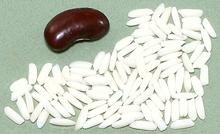 [Glutinous Rice, Sticky Rice, Gao Nep Thuong Hang (Viet)]
[Glutinous Rice, Sticky Rice, Gao Nep Thuong Hang (Viet)]
This is the preferred Sweet Rice in Southeast Asia. It is used in
Thailand, Vietnam, Burma, Indonesia and even Taiwan. It's use extends north
all the way into Assam, India. This is the only acceptable rice to use for
Laotian and Thai Laotian cuisine. For Lao peoples, sweet rice is the main
rice rather than just for sweets and treats. This preference extends
through the Isaan region of Thailand, which is predominantly Lao. It is
soaked for an amount of time dependent on how old the rice is. For rice
exported to North America it is pretty much sure it needs the 8 hour soak
for older rice. It is then steamed in a special conical straw basket lined
with cheese cloth. For details see our
Working with Rice page. These grains, from Thailand were
0.255 inch long by 0.090 inch wide (6.5 x 2.3 mm).
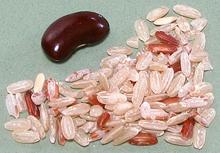 This rice is a mix of three West Java grains, and imported by Lotus
Foods. It consists of Javanese Sintanur brown rice, a very prestigious
rice, mixed with whole red rice and lightly milled red rice.
A cup of rice needs about 1-3/4 cups of water and cooks in about 30
minutes. The photo specimens were 0.257 inch long by 0.080 inch wide
(7.8 x 2.4 mm).
This rice is a mix of three West Java grains, and imported by Lotus
Foods. It consists of Javanese Sintanur brown rice, a very prestigious
rice, mixed with whole red rice and lightly milled red rice.
A cup of rice needs about 1-3/4 cups of water and cooks in about 30
minutes. The photo specimens were 0.257 inch long by 0.080 inch wide
(7.8 x 2.4 mm).
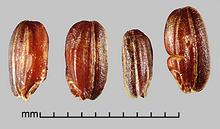 [Oryza rufipogon and hybrids]
[Oryza rufipogon and hybrids]
Various varieties of this wild rice are a difficult to eradicate crop pest
of no commercial value. The seed heads of these varieties tend to shatter
(ripen unevenly and spill their seeds as they ripen). If seeds make into the
harvest, consumers may think they are spoiled, or not really rice, and they
take nutrients intended for the crop. They are listed as "noxious weeds"
in several US States, but these wild varieties are used by plant geneticists
developing new commercial rice varieties.
Photo by Julia Scher, Federal Noxious Weed Disseminules of the
U.S. (Federal Government) = public domain.